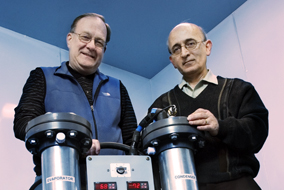
John Meech and Mory Ghomshei: a geothermal heating system for a large building could reduce costs by 75 per cent - photo by Martin Dee UBC Reports | Vol. 54 | No. 1 | Jan. 3, 2008
Tapping into the Heat Beneath Our Feet
Virtually all of Canada’s high-temperature geothermal resources are under B.C. In the next 15 years they can supply 30 per cent of our power needs with the cleanest form of energy known.
By John A. Meech, Professor and Director of The Centre for Environmental Research in Minerals, Metals, and Materials (UBC-CERM3), and Mory Ghomshei, Adjunct Professor and Head of the CERM3-Earth Energy Laboratory in The Norman B. Keevil Institute of Mining Engineering.
With climate change so high today on the environmental and political agenda, substitutes for fossil fuels are under examination. Three significant alternative energy types exist: wind, solar, and geothermal. Each can create electricity, with passive solar and geothermal also able to produce heat for direct use. Wind and solar sources are intermittent, while geothermal is available all the time making it a key way to reduce greenhouse gas emissions.
Although high-temperature geothermal energy is a small fraction of total world energy production, it has been growing annually at approximately 3.5 per cent over the past 20 years. About 10 gigawatts (GW) of power capacity exists worldwide with the U.S. producing about 25 per cent of this total and the Philippines about 20 per cent. Iceland is an important supplier at 10 per cent, with additional increases expected to support a European “hydrogen economy” in transportation.
Virtually all of Canada’s high-temperature resources are located in B.C. along the Coast Mountain range. From Harrison Hot Springs to Pemberton to the Stikine and into the Wrangell Mountains, many young volcanic formations contain water and steam at temperatures above 200 °C. Within the next 10 to 15 years, about 3 GW of high-temperature geothermal power will be established to provide the cleanest and greenest form of energy known. This capacity is about 30 per cent of B.C.’s current hydroelectric system and can be used to supply customers outside B.C. who require purchasing carbon credits. Each generating station will typically be able to generate 25 to 100 megawatts (MW) of electrical power as base load energy.
An equivalent amount of energy is also delivered by low-temperature geothermal systems installed worldwide to provide heat and cooling for buildings. These systems are smaller units (3kW to 10 MW) that are much more distributed than are high-temperature sources, since they can be applied to heat individual homes. In all parts of Canada, our homes can be heated using energy extracted from beneath our property.
Two types of low-temperature geothermal systems exist: closed-loop and open-loop. With a closed loop system, several 10-15cm diameter holes are drilled about 15-30m into the Earth. A 12mm diameter loop of hosepipe is placed in each hole to pump-in anti-freeze at about 3-5°C and return it to surface at about 10-12°C. The temperature difference between inlet and outlet represents the energy to be extracted by a heat pump as it boosts the delivery loop temperature to 45-55°C to distribute heat throughout the building. A heat pump is simply a refrigerator operated in reverse using a refrigerant (iso-butane) compression/decompression cycle to transfer heat from the anti-freeze solution into the delivery water loop.
An open-loop system consists of two deep (30-60m) water wells -- one pumping the energy source ground water to a heat pump similar to that of a closed-loop system. This water is injected back into the aquifer to ensure the groundwater table is not drawn down. With proper positioning of these wells, the resource temperature can be maintained at about 10 to 20°C depending on depth and latitude. The energy used by the heat pump in either case is between 20 to 40 per cent of that extracted from the ground.
The installation cost of a low-temperature system is about 50 to 100 per cent higher than that of a conventional fossil-fuel-fired furnace for a single-family dwelling, so this is difficult to justify without GHG emission incentives (carbon credits). Economies of scale are gained with large buildings or by creating a district heating system. The incremental costs can be paid back in three to four years, which is advantageous since long-term (20-25 years) energy operating and maintenance costs are reduced by 75 per cent.
These systems are useable coast to coast and into the far north. The city of Yellowknife, for example, is designing a district heating system using luke-warm waters extracted from the nearby Con Mine. In Springhill, Nova Scotia, a system has been in place for over 10 years to heat an industrial park using 20°C water from an abandoned coal mine.
When combined with high-temperature systems in B.C., Yukon, and Nova Scotia, a total of 42 GW will offset fossil fuel use over the next 15 years. The associated GHG reductions represent 50 per cent of Canada’s Kyoto Accord obligations. This is certainly not insignificant particularly when it will also reduce energy costs by over 50 per cent.
The future for Geothermal Energy Systems is indeed bright and UBCis actively researching the best ways to exploit these technologies in Canada. We have partnered with a flower-growing greenhouse operation in Chilliwack to build a demonstration plant to heat the greenhouse with geothermal energy and remove the current natural-gas boilers. Both high- and low-temperature resources are accessible at this site and so we are also establishing a satellite research station to allow studies into all aspects of geothermal energy systems. For more info: www.cerm3.mining.ubc.ca. |
